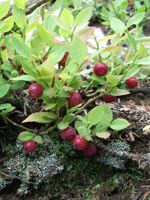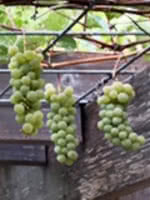Mon-Fri 9am - 5pm Mountain time
Brianna Grape vs Grouseberry
Vaccinium scoparium
Vitis x Brianna
CUSTOM GROW
Grouseberry is a native, low-growing deciduous shrub known for its edible red berries. In early summer, it produces small, urn-shaped flowers ranging from white to pink that attract bees and other pollinators. The berries provide an important food source for many types of wildlife, including game birds such as grouse, which gives the plant its common name. People can also enjoy the berries fresh or in baked goods, though they can be difficult to harvest in large quantities.
Spreading by rhizomes, Grouseberry forms dense, broom-like mats that help stabilize soil and prevent erosion, while also providing cover for ground-nesting wildlife. It is commonly found beneath conifers in open forests, subalpine meadows, and occasionally on rocky slopes in mountainous regions. It is well-suited for naturalization, ecological restoration, and soil stabilization projects.
Brianna Grape is a new grape variety with unique, tropical aromas of mango, banana, and pineapple. Ripening in September, you can use the grapes for juice, white wine, and fresh eating.
Not only is this one of the tastiest grapes on the prairies, it also has above average disease resistance. Consider partnering Brianna Grape with another grape variety to get a higher yield.
Note: We do not ship grape vines to BC due to regulatory restrictions from the Canadian Food Inspection Agency.

